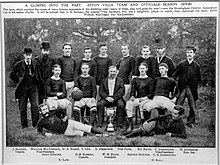Aston Villa F.C. in the 1880s: Difference between revisions
The 1880s was a decade that saw Aston Villa F.C. go from a small club to one that could challenge most teams in the country at the time. It also saw their most significant contribution to the game across the globe, with William McGregor creating the world’s first Football League.
1879–80[edit]

In 1880, nine years before the creation of the Football League, Villa collected their first ever piece of silverware, the Birmingham Senior Cup. They defeated Saltley College 3–2 in the final with goals from Eli Davis, William Mason and George Ramsay in front of 6,000 at Aston Lower Grounds (modern-day Villa Park).[1]
The first “Second City derby” occurred on 27 September 1879, when Villa played Small Heath Alliance. The game, on a pitch at Small Heath’s Muntz Street ground described by the Villa players as “only suitable for pot-holing”,[2] finished 1–0 – recorded as “one goal and a disputed goal to nil”[3] – to the home side.[4]
Villa’s first attempt to win the FA Cup came in the same year, but ended in controversy and confusion. Having defeated Stafford Road 3–2 in the first round replay, Villa were drawn to play the then-successful Oxford University in the second round.[5] Perhaps feeling that it was a waste of time spending good money on travel expenses for a match they felt they would lose, the Villa board took the decision to ‘scratch’ (forfeit) the game.
FA Cup details[edit]
- 1st Round v Stafford Road[6] (A) 1–1
- (Replay) v Stafford Road (H) 3–2
- 2nd Round v Oxford University (A) — (Villa ‘scratched’)
1880–81[edit]
In 1881 Villa departed the FA Cup at the third-round stage. Their first ever official defeat coming against the same team against whom they had achieved their first victory in the competition, Stafford Road. They also defeated Hearts 4–1 in a “glamour” friendly at Wellington Road.
FA Cup details[edit]
1881–82[edit]
This year saw several Club records being set. Howard Vaughton and Albert Brown became the first Villa players to gain international caps. They represented England against Ireland at Belfast. It was not a bad start for the ‘Perry Barr Pets’ either as Brown scored four, while Vaughton scored five in a 13–0 victory.
Vaughton was a dangerous inside-left for Villa throughout the decade, picking up a Cup Winner’s medal before his retirement through injury in 1888. He also owned a silversmith’s which still exists today in Birmingham‘s Jewellery Quarter, and was commissioned to make a new FA Cup trophy when the original was stolen while in holders Villa’s care in 1895. No England player has ever bettered his record of five goals in one international.[citation needed]
It also saw a significant friendly defeat against the famous Queen’s Park club of Glasgow. While Villa were beaten 4–1, they learned from the Scottish club’s innovative passing style. It was about this year that Villa began to wear what were described as ‘maroon’ shirts emblazoned with a large ‘Lion Rampant‘ that now forms the central feature of the club’s badge. The Lion Rampant was chosen by William McGregor as the club’s emblem in tribute to his native Scotland, and also in recognition of the club’s Scottish stars Ramsay and Archie Hunter. This was the first time the Villa kit had come to resemble anything like that worn by the team today. Throughout the 1870s they had worn a variety of kits, including all white, blue and black and all green.
FA Cup details[edit]
1882 also saw a creditable Cup performance as Villa dispatched Nottingham Forest and Notts County (after a replay) before succumbing to Wednesbury Old Athletic in the fourth round (Villa received a ‘bye’ in the second round).
- 1st Round v Nottingham Forest (H) 4–1
- 2nd Round – Villa received a ‘bye’
- 3rd Round v Notts County (H) 2–2
- (Replay) v Notts County (A) 4–1
- 4th Round v Wednesbury Old Athletic (A) 2–4
1882–83[edit]

1883 saw an increased takeover by professionals in the English game with Preston North End, in particular, attracting and paying a number of stars (mostly from Scotland). This move away from amateurism was to prove an advantage for Villa, whose industrial Birmingham home gave them access to large numbers of potential supporters. This in turn meant they could afford to pay decent wages to players with the ticket revenue accrued.
The year also saw Villa’s longest run in the FA Cup. They beat Walsall Swifts, Wednesbury Old Athletic, Aston Unity and Walsall Town before a controversial 4–3 loss to Notts County. A County player appeared to punch the ball off the line in the dying stages, but the referee was unmoved. The beaten Walsall Swifts and Walsall Town would later merge to make the present-day Walsall FC.
FA Cup details[edit]
- 1st Round v Walsall Swifts (H) 4–1
- 2nd Round v Wednesbury Old Athletic (H) 4–1
- 3rd Round v Aston Unity (H) 3–1
- 4th Round v Walsall Town (H) 2–1
- 5th Round v Notts County…
Read More: Aston Villa F.C. in the 1880s: Difference between revisions

